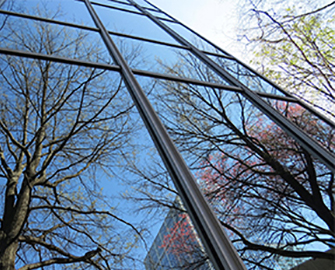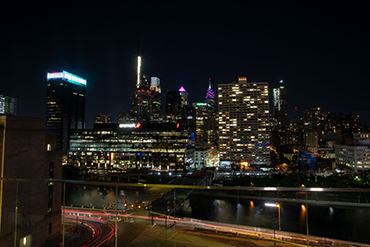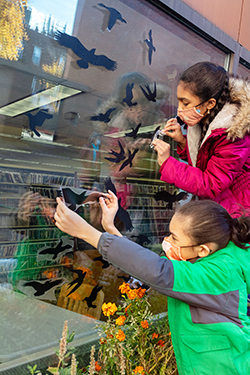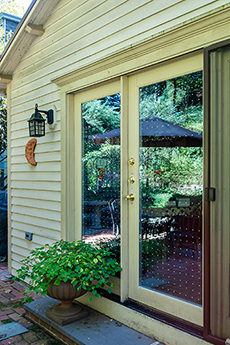
Audubon Adventures

Background for Teachers
Almost everyone has heard it: the loud thump of a bird flying into a window. A few feathers may cling to the glass, ghostly evidence of the impact. And a quick look on the ground outside reveals the extent of the damage: the bird might be lying still, stunned but alive, it might have a broken wing, a broken neck, or, most serious of all, internal injuries such as brain hemorrhage.
Sadly, window strikes and other collisions with buildings are incredibly common. In the United States and Canada alone, between 381 million and 2 billion birds are killed by such encounters each year. Building collisions are a major threat to bird populations, along with feral and outdoor cats (which kill an estimated 2.4 billion birds a year in the U.S.), and habitat loss (the absolute impact of which is difficult to measure). A study in 2019 found that there are three billion fewer birds in North America than there were in 1970. Injury and death resulting from collisions with human-built structures appears to be one factor driving this decline.
 Collisions happen for more than one reason. Most importantly, birds that are not familiar with glass—most birds—are easily fooled by the reflective and transparent characteristics of glass. As a result, when they encounter glass for the first time they frequently fly into it. Although collisions caused by glass occur mainly during the day, they can also occur at night if indoor or outdoor lights make windows visible at night. In addition to glass, artificial lights can attract birds that are migrating at night or otherwise active at night to buildings, causing them to accidentally collide with them or, in the case of upwardly directed search lights, fly around endlessly in these light beams.
Collisions happen for more than one reason. Most importantly, birds that are not familiar with glass—most birds—are easily fooled by the reflective and transparent characteristics of glass. As a result, when they encounter glass for the first time they frequently fly into it. Although collisions caused by glass occur mainly during the day, they can also occur at night if indoor or outdoor lights make windows visible at night. In addition to glass, artificial lights can attract birds that are migrating at night or otherwise active at night to buildings, causing them to accidentally collide with them or, in the case of upwardly directed search lights, fly around endlessly in these light beams.
Collisions can occur throughout the year, but they peak during the spring and fall when birds are migrating between their breeding and wintering grounds. This is when billions of migrating birds—many of which use light cues in the night sky to navigate—are passing through cities and other areas where they are exposed to glass and lights.
 Making Buildings and Our Communities Bird-Friendly
Making Buildings and Our Communities Bird-Friendly
What can be done to help prevent bird strikes? Audubon and partners are working with communities across the country to implement Lights Out programs, a volunteer effort to reduce building lighting, whether that’s by turning off interior lights or floodlights t and other types of external lighting that bathe the outside walls. These measures need only be taken during a few critical weeks of the year to have a massive impact, and have been shown to greatly reduce bird deaths. As a part of some of these programs, volunteers collect information about collisions, identifying problematic buildings, some of which accumulate dozens, even hundreds, of dead birds around them during migration.
It’s not just tall buildings that pose a problem, in fact buildings 14 stories or shorter are involved in 99 percent of collisions. Even a well-lit single-story house can cause bird strikes. Closing curtains or shades when interior lights go on can reduce the light that attracts birds in the evening. Turning off outdoor lighting or putting outdoor lights on motion sensors can ensure that these sources of light are only available when needed greatly decreasing their threat to birds. Installing shields on outdoor lights to direct light toward the ground where people need it can also make a big difference. Such Dark-Sky-approved lighting reduces overall light pollution, which aids plants, animals, and people alike.
 Helping birds see glass as a barrier is also a critical part of the solution. Some glass is manufactured with fritting or acid etching—dots, stripes, or other designs added to the outside of the glass that reduce its reflectivity and transparency and make it easier to see that the glass is a solid barrier. Most glass lacks fritting or acid etching, but there are other ways to make windows a more obvious barrier to our feathered friends. Adding screens to the outside of a window both breaks up reflections and provides a softer impact; if a bird flies into the window, it will hit the screen first and will be less likely to be injured. Window-safe markers or paints can be used to add decorations—dots, lines, or an entire mural—to the outside of a window. Care must be taken to cover all areas of the glass, leaving no more than a two-inch gap between items, vertically or horizontally. This prevents the smallest birds from attempting to zip through an apparent gap. Since Ruby-throated Hummingbirds are highly susceptible to window strikes, such placement can go a long way toward protecting them and other small species.
Helping birds see glass as a barrier is also a critical part of the solution. Some glass is manufactured with fritting or acid etching—dots, stripes, or other designs added to the outside of the glass that reduce its reflectivity and transparency and make it easier to see that the glass is a solid barrier. Most glass lacks fritting or acid etching, but there are other ways to make windows a more obvious barrier to our feathered friends. Adding screens to the outside of a window both breaks up reflections and provides a softer impact; if a bird flies into the window, it will hit the screen first and will be less likely to be injured. Window-safe markers or paints can be used to add decorations—dots, lines, or an entire mural—to the outside of a window. Care must be taken to cover all areas of the glass, leaving no more than a two-inch gap between items, vertically or horizontally. This prevents the smallest birds from attempting to zip through an apparent gap. Since Ruby-throated Hummingbirds are highly susceptible to window strikes, such placement can go a long way toward protecting them and other small species.
What to Do After a Window Strike
If a bird strikes a window, it’s important to investigate. If you don’t see the bird, it likely flew away, but the bird may be sitting on the ground, stunned. If you can see it breathing, keep an eye on it from a distance for a few minutes. It may recover and fly off on its own. If that doesn’t happen, slowly approach the bird. If it flies away, that’s good news. But if you can get close enough to capture it, then the bird definitely needs to be taken to a wildlife or bird rescue and rehabilitation person or facility. If the bird is in a hard-to-reach location or if it could injure you using its beak or talons to defend itself, contact a rehab person or facility before risking your own safety. If the bird is in a location where it could be at risk while it recovers and you can safely do so, gently place it in a cardboard box (with holes!) or paper bag. When you hear rustling inside, it’s time to release the bird in a safe location outside. It’s always a good idea to wear gloves when handling wild birds.
Creating Bird-Friendly Spaces
 Birds are an essential part of the ecosystem. We need them! They disperse seeds, pollinate plants, control insect pests, and clean up dead carcasses. They’re also beautiful and watching them not only connects people to nature, it also drives a billion-dollar industry. So what can we do to create bird-friendly spaces?
Birds are an essential part of the ecosystem. We need them! They disperse seeds, pollinate plants, control insect pests, and clean up dead carcasses. They’re also beautiful and watching them not only connects people to nature, it also drives a billion-dollar industry. So what can we do to create bird-friendly spaces?
In addition to making windows and buildings safer for birds, we can ensure that birds have all the habitat requirements they need to succeed. That involves planting native plants that provide essential food sources (native plants are important, because birds evolved to eat them or the insects that specialize on them; many popular garden plants don’t provide nutrition in this way). Create a three-dimensional landscape with a variety of plant types to provide shelter, nesting sites, and food. Avoid using pesticides or herbicides, which can poison birds directly—or indirectly, when they ingest insects or seeds contaminated by harmful chemicals. This also creates a safe space for young people, as well as a place where people, birds, and other wildlife can co-exist. And finally, another action that protects birds is to keep cats inside. Feral cats or pet cats that live or are allowed outdoors kill millions of birds every year.
Photos: (top and bottom) Mike Fernandez; Adam Betuel; Luke Franke.




